
Editor’s note: This week we’re publishing excerpts from FM 21-20, an Army field manual from 1946 that includes the physical training program used by GIs during WWII. You can read the story behind FM 21-20 here. This series may offer you practical suggestions on exercises to incorporate into your own workouts, or simply inspire you to get in shape and embody the kind of strength and fitness that would make your grandpa proud!
WWII Workout Week concludes with some exercises you can do to improve your posture. While posture is an oft neglected part of physical training programs, it provides a myriad of benefits and can boost both your physiological functions and your confidence.
We hope you’ve enjoyed this series of posts. FM 21-20 includes several other workouts and training regimens, including rifle exercises, survival swimming, and combatives that we’ll definitely be calling out on their own down the line. Until then, train hard; our grandfathers got fit to protect freedom — honor their memory by staying in fighting shape!
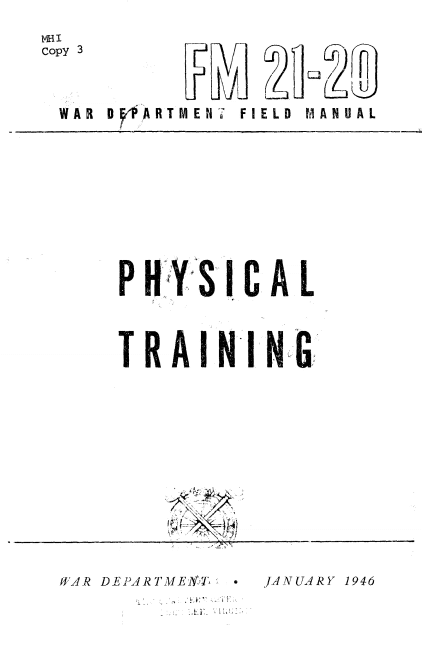
FM 20-21: War Department Field Manual, 1946
Posture Training
GENERAL
PRINCIPLES OF POSTURE TRAINING. There is no one “best posture” for all men because the physical architecture of individuals differs according to the bony structure they inherit. Therefore, to develop the best posture for each member of any given group certain general principles must be applied intelligently to the group as a whole as well as to each man. These principles are:
a. To teach the characteristics of good posture.
b. To provide an opportunity to “feel” or practice good posture.
c. To have the men practice proper posture until it feels more comfortable than poor posture.
d. To motivate the men to acquire it as a habit.
CHARACTERISTICS OF GOOD POSTURE. The first step in posture training is to teach what good posture is. Many men have a misconception as to what constitutes good posture. For example, they arch the lower back, thrust out the chest and retract the shoulders in an exaggerated manner, or they spring their knees backward. The characteristics of good posture are head balanced and erect, chest held high without tension, abdomen flat, shoulders back and relaxed, lower back only slightly curved, and knees straight but not stiff. Instructors should explain and demonstrate the position of the various parts of the body in proper posture.
TRAINING FOR GOOD POSTURE. The men must be provided with opportunities to feel and to practice good posture. Many individuals feel more natural while maintaining a bad posture. Certain muscle groups must have special training to maintain good posture without undue fatigue. The exercises below will provide this training. The emphasis upon proper posture must not be confined to physical training periods only. A good military bearing must be insisted upon until the men assume it from habit.
MOTIVATING GOOD POSTURE. Regardless of the amount of exercise and instruction they get; men habitually assume good posture only if they want to. That is why motivation is so important.
a. At the beginning, a short talk should be given, illustrated if possible, on reasons for cultivating good posture. Good posture has many values for the soldier. First, a soldier is often judged by his appearance – the man with good posture looks like a soldier, he commands attention. Secondly, it is an accepted psychological fact that good posture is associated with good morale – a man with a good posture feels better and is more positive. A man with poor posture cannot feel as positive, consequently he may develop a negative and discouraged attitude. Thirdly, good posture permits the body to function most efficiently. This is because the opposing muscle groups balance, thus maintaining the bony structure in a balanced position. The correct bony alignment provides for the correct positions of the internal organs. The correct positions of the organs assist them in the performance of their various functions. Less strain and tension is placed upon bones, muscles, ligaments and organs.
b. The instructors should always be excellent examples of good posture. They must be enthusiastic about it and “sell it” to the men. Men with excellent posture should be complimented. They should be reminded when they exhibit poor posture. This should be done without nagging, and with humor, if possible.
c. Visual aids should be utilized. A few pictures of good posture and a few signs at familiar places will remind the men to emphasize good posture. These help to motivate many of the men.
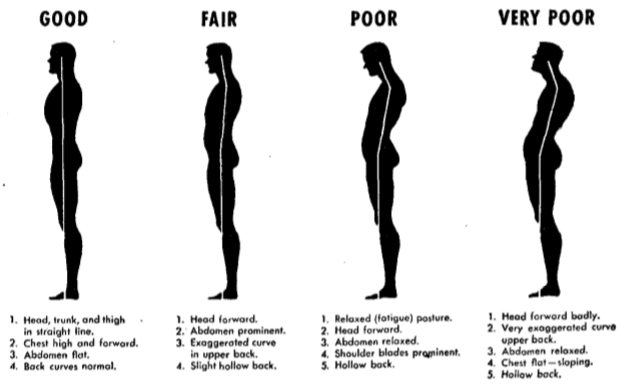
d. Posture judgments help to motivate the men. The four posture silhouettes above are highly valid standards by which to make such judgments. It takes a few minutes to judge 100 men, especially if they are inspected in small groups. They should also be judged occasionally when off guard. Announcing the platoon with the best average posture may stimulate friendly rivalry.
POSTURAL EXERCISES
GENERAL. The ten exercises below are designed to develop the postural muscles. All of these exercises have SLOW CADENCE and two-count movements. They are especially valuable for use in the “strength course.”
EXERCISE 1
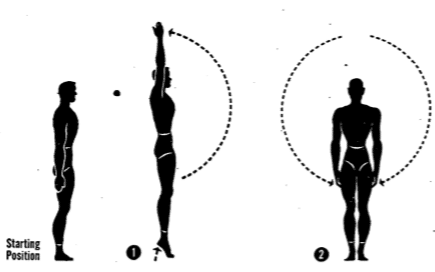
Starting Position. Attention.
Movement:
(1) Swing arms forward and upward to full stretch overhead and at the same time rise high on toes.
(2) Swing arms sideward and downward slowly and press back hard. At the same time retract chin and let heels drop to the ground. Avoid an exaggerated arch in lower back.
EXERCISE 2
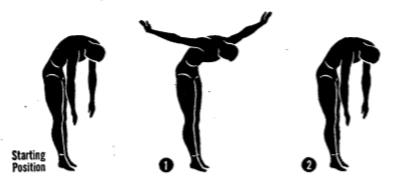
Starting Position. Trunk leaning forward about 60°, arms hanging downward loosely from shoulders.
Movement:
(1) Swing arms sideward and backward vigorously, retracting chin forcefully and flattening upper back. Hold this position momentarily.
(2) Recover to starting position.
EXERCISE 3
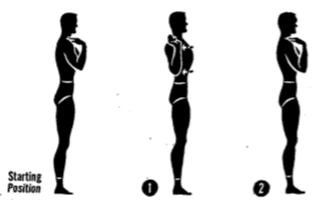
Starting Position. Standing, fingertips touching shoulders, arms in front of chest, and elbows downward.
Movement:
(1) Move upper arms outward and backward, with elbows hugging sides. Hold the position a full second while trying to force arms further around and back. At same time, retract head and attempt to stretch upward.
(2) Recover to starting position.
EXERCISE 4

Starting Position. Kneeling on the mat, trunk bent sharply forward, hands behind head.
Movement:
(1) Still leaning forward, straighten upper back and press elbows and head backward. At the same time pull in chin.
(2) Recover to starting position.
EXERCISE 5
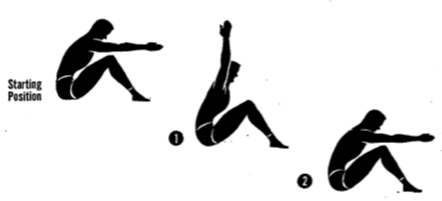
Starting Position. Sitting on the floor, knees raised, trunk bent forward, and arms stretched forward.
Movement:
(1) Still leaning forward, swing arms upward and backward. At the same time pull in chin.
(2) Recover to starting position.
EXERCISE 6

Starting Position. Lying face down on the floor, with elbows at sides and fingertips on shoulders.
Movement:
(1) Rotate arms outward and pull elbows in hard to sides. At the same time pull in chin and lift head about 6 inches from the floor. Hold this position a full second.
(2) Recover to starting position.
EXERCISE 7
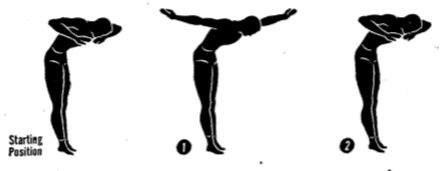
Starting Position. Bending forward about 45°, elbows horizontally sideward from shoulders, forearms bent forward, palms down, thumbs just in front of shoulders.
Movement:
(1) Straighten elbows and swing arms slowly but hard sideward and backward. At the same time retract head.
(2) Recover to starting position.
EXERCISE 8

Starting Position. Leaning slightly forward, elbows bent, and fingertips touching shoulders.
Movement:
(1) Make small circles about a foot in diameter, elbows circling upward and backward. Press arms backward and retract head. Movement is slow.
(2) After completing sufficient repetitions, recover to starting position.
EXERCISE 9
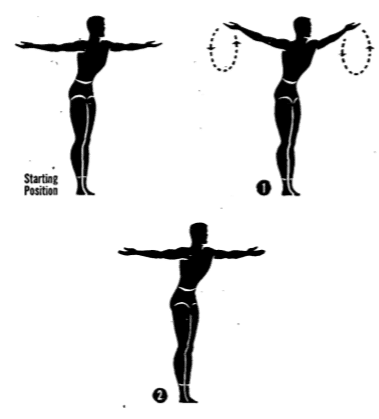
Starting Position. Leaning slightly forward, arms horizontally at sides, palms up.
Movement:
(1) Make small circles about a foot in diameter, hands circling upward and backward. Press arms backward and retract head. Movement is slow.
(2) After completing sufficient repetitions, recover to starting position.
EXERCISE 10
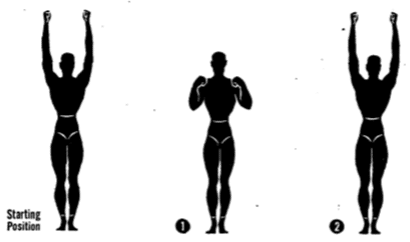
Starting Position. Arms overhead.
Movement:
(1) Pull arms slowly downward until fists are beside shoulders. Pull as though chinning.
(2) Recover to starting position.
Read the Entire Series
The Importance of Physical Fitness
Conditioning Exercises
Log Exercises
Strength Course
Guerilla Exercises
Running and Grass Drills


